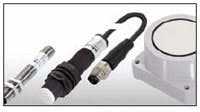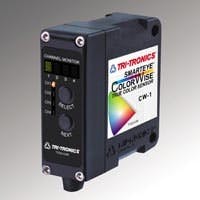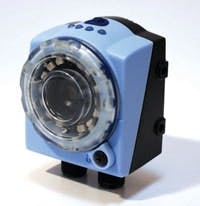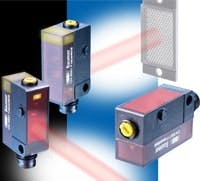As society's product needs change, sensors have had to evolve with them, explains Tina Lockhart, director of engineering for Moore Industries (www.miinet.com). "Today's sensors, integrated with high-integrity transmitter electronics, deliver accuracy, flexibility and performance that was previously not possible," she says.
Sensing technologies each tend to have their own niche applications, explains John Matlack, global business development manager, Macro Sensors (www.macrosensors.com). "LVDTs compete with other position sensing technologies but are selected when ruggedness, resolution, life expectancy and cost are at a premium," he says. "Sensors are used to optimize efficiencies and feedback information to a control system. A production facility needs to measure the products it makes in order to know a good part from a bad one."
Two applications that need non-contact infrared measurement are hot metal detection on an automated rolling mill for any type of metal and boiler temperature within thermal reactors used for sulfur recovery, explains William "Bud" Foran, director of sales at Williamson (www.williamsonir.com). "Without hot metal detection, the drives that move the metal on a rolling mill could not be sequenced properly and, without a continuous measurement and control of a high temperature thermal reactor, process efficiency and the reactor could fail," he says.
"For machine or operational sequences, it is necessary to know that the part is in position and in the correct orientation for the next step of the process," says Gary Frigyes, product marketing manager for photoelectric sensors at Pepperl+Fuchs (www.pepperl-fuchs.us). "Sensors will detect and verify these process steps are followed and accurately completed without guesswork using timers and software." Sensors are a must for error-proofing applications and in applications where machine damage can occur due to part jamming, he explains. "An example would be using a photoelectric sensor to ensure part ejection from the die in a stamping application," says Frigyes.
"In most automated machines, it is critical to know whether a part is in place before the next operation occurs," says Tonty Udelhoven, sensors division director, Turck (www.turck.com). "This is critical to building an error-free subassembly."
A sensor must be matched well for its application, explains Don Martin, president of Lion Precision (www.lionprecision.com). "For measuring displacement there are the sensing requirements of resolution, bandwidth and linearity," he says. "For all sensors there are other environmental requirements of survivability and signal immunity to environmental effects such as EMI and immunity to drift cause by temperature, for example."
Certain requirements exist for communicating the output of the sensor to the controlling or monitoring device, says Martin. "In general, the two options are analog voltage or using a digital protocol," he explains. "To be a true sweet spot, in addition to making a good measurement a sensor must easily integrate into the larger system. If, for example, one is using an industry standard such as cRIO from National Instruments, the system design is simplified and installed cost is reduced if the sensor electronics can be plugged directly into the cRIO chassis. Through the use of transducer electronic data sheets, a smart sensor will be able to communicate additional information such as its sensitivity, measuring range and serial number. The most sophisticated sensors, sometimes referred to as intelligent sensors, will also provide diagnostic information about the sensor, cables or other aspects of the sensor's current state."
For the simplest and most common functions, sensors are extremely abundant in the packaging and conveying industry, where sensing of presence or distance is required, says Lenny Filipkowski, product manager, industrial components, at AutomationDirect (www.automationdirect.com). "As more and more manufacturing processes become automated, sensors are a must in several areas of the machine building industry," he says. "Sensors are needed to detect everything from positioning the end product in the proper place in the machine to detecting the exact location of the tooling, and even detecting humans' presence for critical safety."
Food and beverage customers use powerful disinfectants to keep their manufacturing areas sanitized, says Craig Brockman, marketing manager, presence sensing, at Rockwell Automation (www.rockwellautomation.com). "Their stringent washdown practices neutralize germs and bacteria, but they also can corrode essential equipment like proximity sensors, which safeguard against errors in the process," he says.
The sensor's sweet spot, in terms of applications, is to provide closed-loop feedback from the measurement to help the system deliver optimum performance, says Karmjit Sidhu, vice president of business development for American Sensor Technologies (www.astsensors.com). "Sensors are a must in safety and control in applications such as nuclear power plants, aerospace and transportation," says Sidhu. "In each of the applications, sensors are widely used to shut a process down to avoid costly conflicts."
Ultrasonic sensors are ideal for applications where the combination of a long sensing range and high degree of immunity to ambient factors such as dust, dirt or background light is required, explains Roger Altendorf, product specialist at Balluff (www.balluff.com). "A very typical application where they can be found is in bin-level control for granular substances," he says.
"When an object needs to be measured for some form of shape or has a component of dimension in the Z direction, a 3D sensor is the sweet spot," explains Barry Dashner, vice president of marketing at LMI Technologies (www.lmint.com). "It comes down to value. Does the function improve some manufacturing capacity, find problems sooner to eliminate waste or perform a function that couldn't be done before?"
Mark Lehmann, director of product management, sensors, at Watlow (www.watlow.com) indicates exhaust gas temperature sensing for diesel engines is a sensor sweet spot. "Exhaust gas temperature sensors are required for engine OEMs to meet the ever-increasing demand for cleaner, better-performing engines," he says.
The measurement and control of flow is critical in applications such as reverse osmosis systems to ensure membrane protection and in injection molding systems where the parts must be evenly cooled by a steady flow rate, explains Charles Nobile, sales engineer at Bürkert Contromatic (www.burkert-usa.com).
MagnePot Model 6120 Hall Effect position sensor features extremely low mechanical torque with a programmable electrical angle from 5 to 360°. The MagnePot sensor is available in three standard configurations plus custom models and features low noise and a rotational life to 10 million cycles. Standard independent linearity is ±0.5%, with tighter linearity available on spec units. Typical output voltage ranges 0.25–4.75 Vdc, while input voltage ranges 4.5 Vdc–5.5 Vdc.
BI Technologies
714/447-2345
POWERLINK INTERFACE
Temposonics magnetostrictive linear-position sensors now include the R-Series Ethernet Powerlink sensor. A resolution of 1 micron (0.00004 in.) is possible for lengths from 25 mm to 20000 mm. Position and velocity measurements can be provided for up to four locations on the sensor. For higher accuracy requirements, a linearity correction option is available to improve the sensor's non-linearity specification within ± 20 μm. Even better sensor accuracy (±10 μm) is available with a proprietary magnet.
MTS Systems
919/677-0100
The OPB732 Series long-distance infrared reflective switch's non-contact design features an emitter and sensor protected from contaminants by a clear window. The OPB732 Series switch has a reflective distance of more than 1 in., depending on circuitry. The reflective switch configuration includes an infrared LED and phototransistor and uses an opaque housing to reduce the sensor's ambient light sensitivity. Operating temperature range for the long distance reflective switch is -40 °C to +85 °C.
Optek Technology
972/323-2200
The inductive rotary encoders of the ExI 1100 series are available in versions whose mating dimensions are the same as those of common types of resolvers. The ExI 1100 rotary encoders with EnDat 2.1 interface feature an inductive scanning method, with which the single-turn resolution is 18 bits (262144 position values per revolution). The single-turn position value is produced by electronics already integrated in the encoder and is transferred as purely digital information to the electronics over the bidirectional EnDat interface.
Heidenhain
847/490-1191
The BIM-UNT line of compact cylinder position sensors includes a dual sensor for detecting long-and short-stroke cylinders. The dual sensor is designed to be useful for detecting the home and end position of a piston for longer stroke cycles. The sensor's low profile is suitable for applications with minimal clearance around cylinders, and it can be used in places where multiple cylinders are installed, requiring one cable.
Turck
800/544-7769
Ultrasonic sensors offer multiple sensing ranges from short to long (up to 6 m, 19.7 ft). Available in a variety of tubular and block style housings, these sensors have a rugged industrial IP65 or IP67 protection rating. With discrete, analog or combination output configuration options, the ultrasonic sensor family has been designed to work with many industry-standard controllers. The ultrasonic sensors have programmable setpoints and operating modes.
Balluff
800/543-8390
The ECD140 sensor adds displacement and position data to test, measurement and control systems designed around National Instruments' CompactRIO architecture. Based on eddy-current (inductive) sensing technology, the sensor provides displacement measurements of conductive targets with sub-micron resolutions and measurement ranges of 2–3.5 mm. Other ranges are also available upon request.
Lion Precision
651/484-6544
The sanitary RTD sensors feature two types of probes. Heavy-duty probe stem has a stepped design for additional strength, and standard duty is ¼ in. diameter probe. Both feature standard probe lengths of 3, 4, 5 and 6 in. with other probe lengths available. Both heavy duty and standard duty feature wetted surfaces that are 316L stainless steel, and surface finish equals 32 μin. or better. Both probes are designed for CIP and sanitary process.
Omega Engineering
203/359-1660
The R58A Series sensors for detecting registration marks in printing and material registration applications feature simplified setup via potentiometer adjustment of the switching threshold and switch-selectable light/dark operate. The sensor's warm-up period, 10 kHz switching frequency and 15-μs repeatability are designed to ensure reliable detection in high-speed printing and web processing applications. The sensor, with its metal housing and acrylic lens, features contrast sensitivity and offers a 1.2 x 3.8 mm sensing image.
Banner Engineering
888/373-6767
The ProSense line of process sensors includes temperature switches, temperature transmitters and RTD temperature probes. The TSD25 series switches offer dual-output setpoints over an operating temperature range of -13 to 284 °F. With 4-20 mA analog outputs, the TTD25 series of transmitters provides a compact temperature monitoring system over temperature ranges 0–100 °C or 0–300 °F. The four-wire, 100-Ohm platinum RTD probes are made of 316 stainless steel and measure temperatures ranging from -40 to 302 °F.
AutomationDirect
770/889-2858
The W4S-3 INOX photoelectric sensor features an IP 69K stainless-steel housing. The W4S-3 incorporates OES3 technology into the custom application-specific integrated circuit (ASIC). These sensors are designed to ignore stray background reflections, detect multi-colored or shiny objects and provide high immunity to ambient light. They feature a smooth, stainless-steel housing to reduce the risk of bacteria growth that can result when food particles become lodged in the housings' small grooves or crevices.
Sick
800/325-7425
The View Series sensors expand the line's photoelectric sensor capabilities and address a spectrum of application challenges. It's comprised of the IntelliView and the NanoView product families. The IntelliView sensors are compact specialty photoelectric sensors, while the NanoView sensors are sub-miniature rectangular photoelectric sensors designed for applications where optical performance is important but smaller, less expensive sensors are required.
Eaton Electrical
800/426-9184
The Type 8012 Flow Sensor for continuous flow measurement features optic- or magnetic-based measurement with programmable analog output of 4-20 mA or digital output by frequency or switch. The Type 8012 also can be installed on fluid block systems. Medium temperature ranges depend on the fitting material: 32-140 °F (PVC), 32-176 °F (PP) and 5-212 °F (SS or PVDF) if ambient temperature is ≤113 °F or 5-194 °F (SS or PVDF) for ambient temperatures in the 113-149 °F range.
Bürkert Fluid Control Systems
949/223-3100
The RPS-409A-IS is an intrinsically safe, UL-listed analog ultrasonic sensor. It is a self-contained sensor in a 30 mm PVC barrel housing. It is powered by 16-30 Vdc with reverse polarity protection. It also has a narrow beam angle, designed for tight places. A flat target can tilt up to 10° and be detected. The RPS-409A-IS has a short-circuit-protected analog 0-10 Vdc output. The RPS-409A-IS has built-in temperature compensation, designed to provide accurate readings throughout the entire operating temperature range.
Migatron
888/644-2876
The UNIK 5000 pressure sensing platform is based on a modular design to allow users to customize pressure measurement parameters. Druck silicon technology is at the heart of the new platform, resulting in a range of piezo-resistive pressure sensors. UNIK 5000 sensors are available with pressure ranging 1.5–10000 psi. Three grades of performance—industrial, improved and premium—offer accuracies from 0.2% to 0.04%. A selection of eight electronics boards provides a choice of outputs.
GE Sensing & Inspection Technologies
800/833-9438
The LS5 Navigator is designed to withstand wide variations in temperature (-30 °C to +50 °C) and relative humidity (up to 95%), as well as mechanical stress like vibrations and shocks. The LS5 Navigator comes with an optics system and is adaptable to different types of communication. It also works with AutoSurveyor—a software tool for determination of reflector coordinates. The LS5 Navigator is available in two versions: one for outdoor/indoor use and one for indoor use only.
Kollmorgen
540/633-3545
The Exactsense thermocouple for high-temperature exhaust gas temperature sensing has an electronic housing with an integrated molded connector that is available with either an analog or digital output signal. Combining the sensor and the electronics provides an output signal compatible with engine control modules (ECMs), minimizes system error because the sensor and the electronics are integrated and enables the use of information about the sensor such as sensor identification, serial number, calibration, drift and time response data.
Watlow
800/watlow2
Bulletin 871TS inductive proximity sensors are designed to withstand high-pressure and high-temperature washdowns while offering resistance to corrosion and damage caused by harsh-cleansing agents. The Bulletin 871TS sensors have been subjected to rigorous chemical compatibility testing by Ecolab and have been certified compatible with many caustic cleaning agents and disinfectants.
Rockwell Automation
414/328-2000
The PR 750 Series of 3/4 in. (19 mm) diameter ac-operated LVDTs are general purpose contactless linear position sensors. They are available in full-scale measuring ranges from ±0.050 in. (±1.25 mm) to ±10 in.s (±250 mm) and offer a core-to-bore radial clearance of 0.031 in. (0.25 mm) with the standard core supplied. The maximum linearity error for any of these sensors is ±0.25% of full range output. Their external sealing meets IEC standard IP-61.
Macro Sensors
856/662-8000
The E3Z photoelectric sensor family includes an advanced condition monitoring series, 30 m through-beam models, oil-resistant series and stainless-steel sensors. The E3Z dc sensor has a built-in amplifier with pulse synchronization. Intensive shielding is designed to prevent malfunctions due to inverter noise or wireless communications equipment. The electronics are fully potted to resist dust and high pressure water spray up to 1200 psi. Stainless steel E3ZM series are rated IP69K to match 1450 psi wash-down applications.
Omron Electronics
866/88-omron
Ready-To-Install (RTI) temperature transmitter assemblies for surface measurements mount directly to tanks, pipes, motors, compressors, reactors or anywhere a surface temperature measurement is needed. These assemblies, classified as RTI-3 temperature assemblies, include the Worm Flexible Sensor coupled with the PC-Programmable or Smart HART temperature transmitters. The Worm spring-loaded flexible sensor trims-to-length and slides through the connection head port and into the assembly.
Moore Industries
818/894-7111
The DK50-UV luminescence sensors detect marks such as inks, pigments, dyes, coatings and adhesives, even on irregular backgrounds, and deliver a luminescence sensing range of 600 mm. These sensors are UL and cUL listed and feature up to four automatic teach modes and one manual teach mode. Additionally, the DK50-UV features a graphical, eight-segment LED display that indicates luminescent signal strength, an output mode toggle and an integral timer that allows slower controllers to react to sensor output.
Pepperl+Fuchs
330/486-0001
These light curtains feature 94 cross beams, optical synchronism and no need of external control boxes. In addition, they are available with integrated solid state and relay outputs. The light curtains have a switching distance of more than 12 ft, operate on 12 - 24 Vdc and come with both a supply indicator and an output indicator. They are protected from short circuit and polarity reversal and offer a sensitivity adjustment. Automation Systems Interconnect
877/650-5160
Gold Series single-wavelength infrared temperature sensors are available in a range of short, long and specialty wavelengths. The sensors measure the amount of infrared energy emitted by an object's surface and then convert this signal into a temperature value between -40 °F and 4500 °F (between -40 °C and 2475 °C). Each model can be used as a stand-alone transmitter with a choice of inputs, outputs and alarms. For more advanced capabilities, interface modules, PID controllers and PC software programs are available.
Williamson
978/369-9607
The SmartEye ColorWise sensor includes a four-channel monitor to provide a continual visual confirmation of performance. Features of the spectrometer-like color sensor include selectable outputs, timers, resolution and speed; four digital outputs and three analog outputs; selectable speed vs. resolution; and color capture from HMI, PLC and remote button.
Tri-Tronics
800/237-0946
NINE INSPECTION TOOLS
Datasensor SVS sensors include a frame rate of 60 fps (60 images/s), Ethernet communication, a teach button, 640x480 pixel resolution and nine inspection tools, including pattern match, contour match, positioning verification, width comparison, edge count, brightness check, contrast comparison, character verification and unique 360° pattern match. SVS smart vision sensors are available in two product lines. The SVS1 models guarantee quick and easy setup via hand-held configurator, and the SVS2 models can be connected to a PC and offer multiple controls.
IDEC
800/262-idec
XUV ultrasonic sensor uses thru-beam technology to detect labels of any material, size, color or translucency. It detects labels between thicknesses of 0.03 mm (0.001 in.) and 0.08 mm (0.003 in.). The detection threshold of the sensor is adjusted using the +/- keys on the sensor. Rated IP65, the sensor has an operating range of 5 ºC to 55 ºC (41 ºF to 131 ºF).
Schneider Electric Sensor Competency Center
800/435-2121
RS49 rotary sensor, designed for mobile and industrial applications, is a 0-5 V output, non-contact sensor that supports either single or dual outputs. It can measure rotary position or motion, and has a factory programmable angle of operation ±45°. Designed with a high-level of electromagnetic immunity, the sensor has over-voltage, reverse polarity protection and is RFI filtered.
Parker Hannifin, Electronic Controls Div.
572/254-4265
PSENslock secure safety gate system combines secure safety gate monitoring and a non-contact magnetic interlock in one unit. It is designed for applications up to SIL3 in accordance with EN/IEC 62061, Category 4 in accordance with EN 954-1 and protection type IP67.
Pilz Automation Safety L.P.
734/354-0272
OGL 55/54 optical angle sensor, an alternative to a proximity sensor, is designed for presence and part detection. These fork sensors align the transmitter and receiver in a fork like housing to guarantee sensor alignment. The sensor comes in metal or plastic housings and includes contamination detection via a LED that notifies users if oil, grease, dust or other contaminants are present.
TR Electronic
519/452-1999
GT all-in-one integrated contact sensor for height and thickness measurements requires no external PLC or external data processing. Designed for automatic in-line measurement, the IP67-rated GT has a linear ballbearing spindle tip that pneumatically extends and retracts for each measurement cycle. The ball-bearing tip eliminates wear and abrasion damage from contact with high-speed moving target surfaces.
Keyence of America
888/539-3623
Simatic RF310R and RF380R read/write devices now accommodate both advanced and simple transponders (tags). These HF (high frequency) 13.56 MHz range devices have been redesigned with ISO 15693 functionality making them suitable for tags with little memory, including the MDS D100 and D124 ISO 15693 tags, as well as more sophisticated tags in the RF300 transponder range.
Siemens Energy & Automation
800/241-4453
F3SJ safety light curtains are available in finger protection, hand protection or hand/limb body configurations. Sensors with protective heights of up to nearly 2.5 m are available for applications that involve large-sized workpieces.
Omron Scientific Technologies
510/608-3400
Series 14 photoelectric sensors are now available with a transparent rear housing section that allows the sensor’s interior to be observed, enabling viewing of operating and reception LEDs from practically every angle. This provides an advantage during sensor installation, adjustment and operation.
Baumer Ltd.
860/621-2121
PD30 Series photoelectric sensors come in thru-beam, polarized retro-reflective, diffuse reflective, background suppression, retro-reflective and transparent object detection models. They include pushbutton programming, remote teaching options, mutual interference protection, sensor alignment aid and the ability to verify the sensor’s proper operation remotely via a PLC.
Carlo Gavazzi
847/465-6100
ADAM-5081 is a high-speed quadrature encoder and counter module for use with the ADAM-5550 series programmable automation controllers (PACs). It has a high isolation of 2,500 Vdc, a high speed frequency mode (5 Hz to 1 MHz) and a counter code at 1 MHz. There is also an advanced digital filter to eliminate noise and interference (1 to 65,000 μsec) which ensures accurate data collection and transmission.
Advantech, Industrial Automation Group
800/205-7940








































